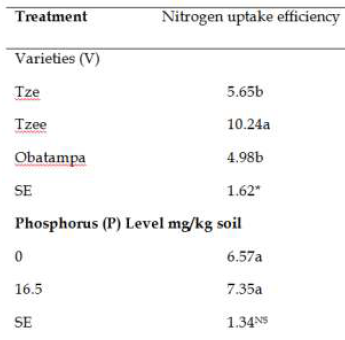SCREENHOUSE EVALUATION OF GROUNDNUT GENOTYPES FORNITROGEN FIXATION AND MAIZE VARIETIES FOR NITROGENUPTAKE EFFICIENCY
Mots-clés :
Screehouse, Genotype, Nitrogen fixationRésumé
Phosphorus is important in the symbiotic association with the bacteria rhizobium, there by fixing atmospheric nitrogen. Due to low availability of the fertility status of most savannah soils, the objectives of this research were therefore; to estimate biological nitrogen fixation by the groundnut genotypes under low and high phosphorus conditions and to determine the nitrogen uptake efficiency of some selected maize varieties. To achieve these objectives, a potted experiment was conducted in the screenhouse of the Department of Soil Science, Ahmadu Bello University Samaru, Zaria. The treatments consisted of a combination of five genotypes of groundnut namely; (Samnut 10, Samnut 11, Samnut 21, Samnut 22 and Samnut 23) and three varieties of maize (TZE, TZEE, and Obatampa). The groundnut genotypes had 60kg P2O5 ha-1 (13.2 mgP/kg soil) and 0kg P2O5 ha-1 (0 mgP/kg soil), the maize varieties had 75 kg P2O5 ha-1 (16.5 mgP/ kg soil) and 0 kg P2O5 ha-1 (0 mgP/ kg soil) levels. The treatments were repeated three times and laid down in a Completely Randomised Design. There was no significant difference in the amount of atmospheric nitrogen fixed by the groundnut genotypes. However, Phosphorus application significantly increased nitrogen fixation compared to the control, therefore 60kg P2O5 ha-1 is concluded for higher nitrogen fixation in the soil.The effect of maize varieties in relation to nitrogen uptake efficiency was significant statistically, this result shows that the varieties that grow and develop extra early takes up more nitrogen faster than the late varieties and early varieties.
##plugins.themes.default.displayStats.downloads##





